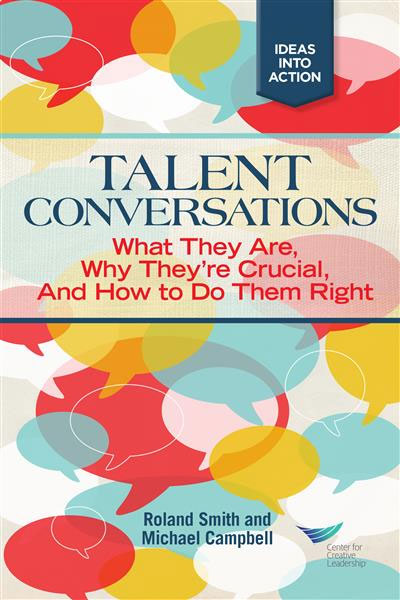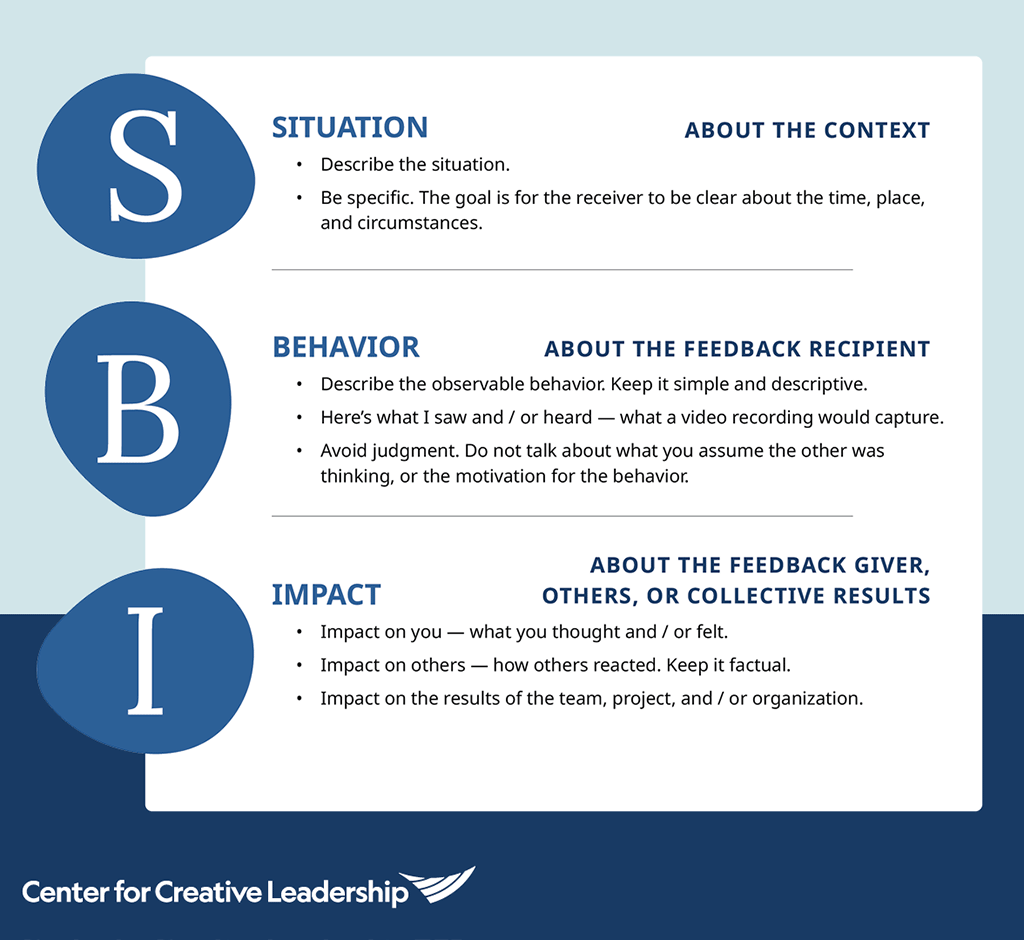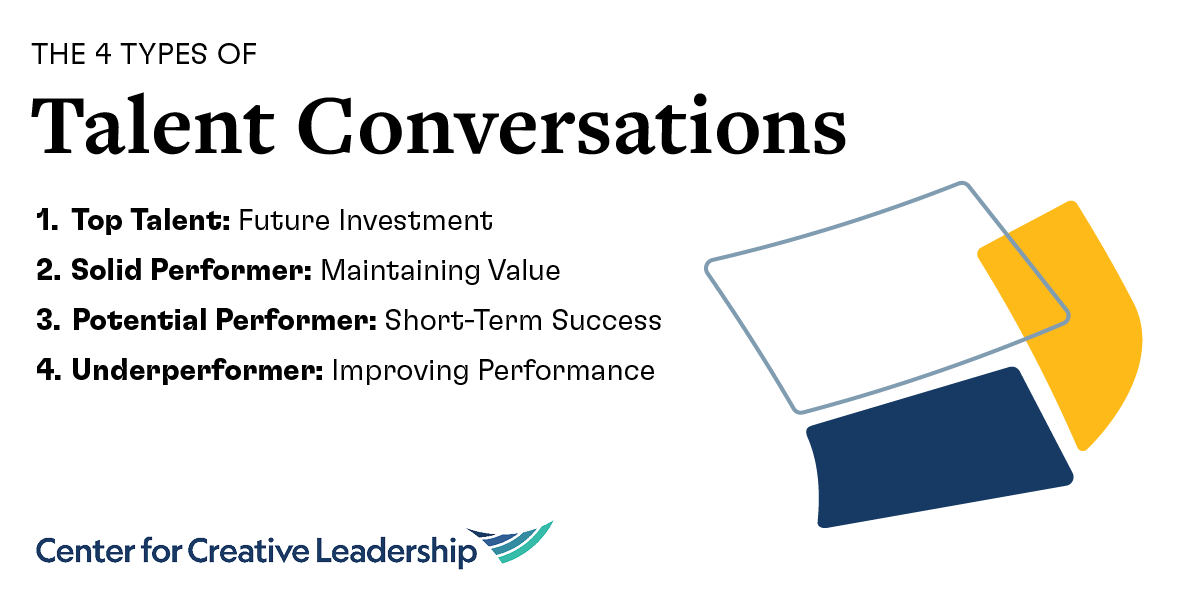How Feedback Conversations Can Strengthen Organizations
What can you do to improve talent development?
Teach your leaders how to give feedback regularly and well (we recommend using our SBI™ feedback model), and help them to hold effective feedback conversations with employees.
This is the fastest way to improve talent development because individual leaders are in the best position to influence and develop talent — or shut it down. Managers can give employees good reasons to be engaged, work effectively, and build their skills.
Most importantly, a talent conversation isn’t done to someone, but with someone. It’s about building a relationship that allows managers to influence employees toward improved performance, development, and positive outcomes.
It’s one of the simplest yet most effective ways to develop others. And, if the employee has been given honest, ongoing feedback, these conversations don’t come as surprises.
Some of the most valuable types of feedback are given in the moment and on routine, day-to-day behaviors. When feedback is given consistently and well, managers establish and strengthen trust. The more trust and rapport managers can build, the more readily subordinates will accept and act on future feedback, creating a pattern of learning and growth.
Hold More Constructive Feedback Conversations With Our SBI Feedback Model
First and foremost, make sure your managers know that giving feedback on a regular basis is more effective than saving it all for the performance review. Ongoing feedback conversations can:
- Motivate employees to continue a behavior that increases their effectiveness
- Encourage them to stop a behavior that reduces their impact
- Encourage employees to adopt or modify a behavior that will make them more effective
- Foster greater commitment to their work and the organization
Secondly, we recommend sharing any feedback using our SBI feedback model. It’s a simple ways for leaders to structure feedback conversations to capture and clarify the Situation, describe the specific Behaviors, and explain the Impact that the person’s behavior had.
Our SBI feedback model can be used to give both positive and negative feedback. It’s a process that may feel awkward or formal at first, but once managers get some practice, they tell us that they find it’s incredibly helpful.
The SBI Feedback Model in 3 Simple Steps
1. Describe the Situation.
Describe the specific situation in which the behavior occurred. Include the time and place to reduce any confusion.
2. Describe the Behavior.
Describe the actual, observable behavior being discussed. Keep to facts only and avoid inserting any opinions or judgments.
3. Describe the Impact.
Describe the results of the behavior in terms of the impact it had, whether the effect was positive or negative.
Take the Feedback Even Further by Asking About Intentions
Our SBI feedback model can be even more helpful when accompanied with an inquiry about intent. This turns the one-way act of giving feedback into a two-way dialogue, a feedback conversation, where both parties can have a clarifying discussion around intentions versus impact. Learn more about using SBI to explore intent vs. impact.
Feedback Conversations Can Be Talent Conversations
Feedback conversations can be thought of as talent conversations. They’re an opportunity for managers to influence their direct reports towards improved performance, development, and positive outcomes.
Feedback conversations can happen at any time, and are part of what it takes to coach your people on an ongoing basis. But one of the most critical moments for holding effective talent conversations is during your organization’s regular performance review process.
Here are some guidelines to consider for those times.
First, Understand the 4 Types of Talent Conversations
Managers need to be prepared to hold 4 types of talent conversations, based on how an employee is doing. The first step is to clarify whether the employee is considered top talent, a solid performer, a potential performer, or an underperformer. The feedback conversation will have a different focus, depending on how the employee is viewed. From there, you will know where to focus the feedback conversation.
The Top Talent Conversation
Focus on future investment. Individuals who clearly meet or exceed expectations and deliver superior results are top talent. These are the individuals who are seen as the future leaders in the organization. Be sure you’re being thoughtful about engaging this high-potential talent.
The Solid Performer Conversation
Focus on maintaining or building value. Solid performers are typically individual contributors who are valued by the organization but could take on more responsibility.
The Potential Performer Conversation
Focus on short-term success for now. Potential performers are individuals who may not have had enough time in their role to show significant results but are expected to bring a lot to the role they’re in.
The Underperformer Conversation
Focus on improving performance. Underperformers are not meeting expectations. The feedback conversation should remain focused on the here and now rather than future options, new tasks, or additional responsibilities. Learn more about managing a difficult employee.

Discover how to use talent conversations to build relationships based on rapport, collaboration, and mutual commitment and help your team improve performance, focus development, and reach positive outcomes.
How to Structure a Feedback Conversation With Your Talent
Whatever other formal talent management or leadership development systems are in place, feedback conversations are where development becomes real. It’s the best time for managers to build their direct report’s commitment to the organization and engagement in the work.
So the feedback conversation itself should have a structure, too. Things will go more smoothly if you follow these 6 steps:
- Clarify the goal. What’s the purpose of the feedback conversation? What exactly does each person want to accomplish?
- Explore the issues. Assess strengths, vulnerabilities, development needs, and performance. Identify motivation and career aspirations.
- Identify the options. Generate ideas and opportunities for learning and improvement.
- Set expectations. What do we want to do first? Next? What are the obstacles?
- Motivate. What support is needed? Are you sure the goals are meaningful? How can I help and what else is needed?
- Identify the plan. How will we know you are on target? How will we track outcomes?
Learn even more about our recommendations for holding feedback conversations with your direct reports in our guidebook, Talent Conversations: What They Are, Why They’re Crucial, and How to Do Them Right.
Demands placed on managers to meet performance goals can be relentless, and priorities and challenges shift frequently. That’s why the key to improving your talent development processes is ensuring that your managers can hold meaningful feedback conversations with talent (and again, our SBI feedback model is a great tool for that).
Ready to Take the Next Step?
Upskill your team’s capacity for holding effective feedback conversations. We can create a customized learning journey for your leaders using our research-based modules. Available leadership topics include Conflict Resolution, Emotional Intelligence, Feedback That Works, Listening to Understand, Psychological Safety, and Talent Conversations.









